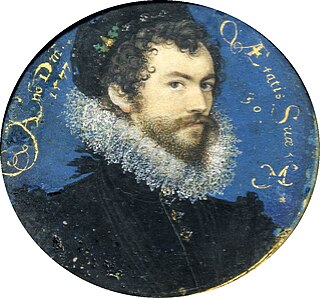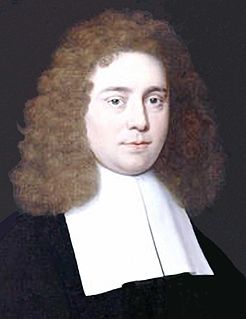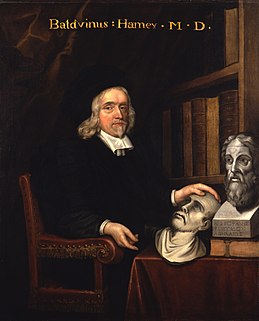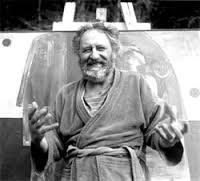
Nicholas Hilliard was an English goldsmith and limner best known for his portrait miniatures of members of the courts of Elizabeth I and James I of England. He mostly painted small oval miniatures, but also some larger cabinet miniatures, up to about ten inches tall, and at least two famous half-length panel portraits of Elizabeth. He enjoyed continuing success as an artist, and continuing financial troubles, for forty-five years. His paintings still exemplify the visual image of Elizabethan England, very different from that of most of Europe in the late sixteenth century. Technically he was very conservative by European standards, but his paintings are superbly executed and have a freshness and charm that has ensured his continuing reputation as "the central artistic figure of the Elizabethan age, the only English painter whose work reflects, in its delicate microcosm, the world of Shakespeare's earlier plays."
The Painter and Limner is a member of the Royal Household in Scotland. Appointments of Court Painters are recorded from 1581 onwards, and the post of Painter and Limner was created in 1702 for George Ogilvie. The duties included "drawing pictures of our [the Monarch's] person or of our successors or others of our royal family for the decorment of our houses and palaces". From 1723 to 1823 the office was a sinecure held by members of the Abercrombie family, not necessarily connected with artistic ability. The appointment of Sir Henry Raeburn in 1823, a few months before his death marked a return to conferring the post on a distinguished Scottish artist. He was succeeded by David Wilkie.

A limnic eruption, also known as a lake overturn, is a rare type of natural disaster in which dissolved carbon dioxide suddenly erupts from deep lake waters, forming a gas cloud capable of suffocating wildlife, livestock, and humans. A limnic eruption may also cause tsunamis as the rising CO
2 displaces water. Scientists believe earthquakes, volcanic activity, and other explosive events can serve as triggers for limnic eruptions. Lakes in which such activity occurs are referred to as limnically active lakes or exploding lakes. Some features of limnically active lakes include:
Events in the year 1822 in Art.
A limner is an illuminator of manuscripts, or more generally, a painter of ornamental decoration. One of the earliest mentions of a limner's work is found in the book Methods and Materials of Painting by Charles Lock Eastlake (1793–1865).
"The treatises [on oil painting] cannot be placed later than the thirteenth, or beginning of the fourteenth, century. This was the age of Dante, and "the art which in Paris was called illuminating" (limning) is well illustrated by such guides." p. 45

Charles Codman was a noted American painter. Codman, who lived his entire life in Portland, Maine, was known for his landscape and marine paintings.

Ammi Phillips was a prolific American itinerant portrait painter active from the mid 1810s to the early 1860s in Connecticut, Massachusetts, and New York. His artwork is identified as folk art, primitive art, provincial art, and itinerant art without consensus among scholars, pointing to the enigmatic nature of his work and life. He is attributed to over eight hundred paintings, although only eleven are signed. While his paintings are formulaic in nature, Phillips paintings were under constant construction, evolving as he added or discarded what he found successful, all while always adding personal details which spoke to the identity of those who hired him. He is most famous for his portraits of children in red, although children only account for ten percent of his entire body of work. One of these paintings would be sold for one million dollars, a first for folk art.His paintings hung mostly unidentified, spare for some recognition in the collections like those of Edward Duff Balken, for decades until his oeuvre was reconstructed by Barbara Holdridge and Larry Holdridge, collectors and students of American folk art, with the support of the art historian Mary Black. Ammi Phillip's body of work was expanded upon their discovery that the mysterious paintings of a "Kent Limner" and "Border Limner" were indeed his.
The year 1547 in art involved some significant events and new works.
The year 1558 in art involved some significant events and new works.
David Abercrombie Donaldson (1916–1996) was a 20th century Scottish artist who served as official Painter and Limner to Her Majesty the Queen in Scotland.

Gerlach Flicke, Latin name Gerbarus Fleccius, anglicised in the 16th century as "Garlicke", was a German portrait painter who is known for his work in London as an artist of the Tudor court. Flicke was imprisoned in London and he made a portrait miniature whilst there. This painting is the earliest self-portrait in oils made in England.

The Drinker's Court, also known as Bandbox Court Houses, is located in the Society Hill section of Philadelphia, Pennsylvania. The houses were built in 1764 by John Drinker (1716–1787), father of noted American portrait artist John Drinker (1760–1826).

John Bettes the Younger was an English portrait painter.
Samuel Cook (1806–1859) was an English watercolour artist.
David or Dave Donaldson may refer to:

Cornelis Jonson van Ceulen the Younger (1634–1715), was an English painter active in the Netherlands.

Matthew Snelling (1621–1678) was an English miniature painter.

Herbert Johannes Josef Siebner was born in Stettin, Prussia, and died in Victoria, Canada. Siebner was an Expressionist painter, printmaker, and sculptor. Siebner studied graphic arts under Max E. A. Richter (1941–43) in Berlin. Siebner served in the German Army from 1943 to 1945, until he was captured by the Russians in 1945. After the war, Siebner studied at the Academy for Fine Arts & Culture, Berlin under Prof. Max Kaus and Ernst Shumacher (1946–49), and was soon exhibiting his works in exhibitions and galleries. Siebner emigrated to Canada in 1954, settling in Victoria, BC, where he opened an art studio and began teaching his craft.

Nehemiah Partridge was an American painter. He is believed to be the same artist as those identified as the Schuyler Limner and the Aetatis Suae Limner, though this identification has been called into question by some historians.
Maiorana is a surname. Notable people with the surname include:
This page is based on this
Wikipedia article Text is available under the
CC BY-SA 4.0 license; additional terms may apply.
Images, videos and audio are available under their respective licenses.










